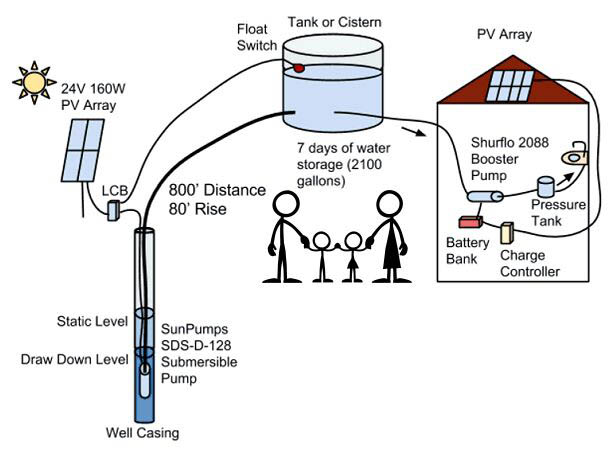Before installing a solar water pump, you should know how to size and determine the various basic components that make up a solar water pump system:
- Solar powered pump that goes in your well.
- Holding tank or cistern to store a reserve of water.
- Solar panel array to power the pump.
- Linear current booster that optimizes the power from the solar panels to the pump.
- Booster pump to increase the pressure of the water to usable household levels (if your cistern isn’t high enough).
When determining what solar water pumps to get, you need to evaluate your pumping needs. How much water a day do you need, how many days of storage, how high and far does it need to be pumped, and what is the source? Seventy five Gallons per day (GPD) per person is common for domestic use. Your local weather patterns will help determine the amount of storage; do you have long stretches without sun, or is it only an occasional cloudy day?

Sizing the Water Storage Tank or Cistern for a Solar Pumping System
To figure out how much water they need to store in case there is little sun during rainy days we will take the amount of water they need per day per person, multiple it by the number of people and then how many days you can expect (worse case) to would would go without sunlight.
Sizing the Submersible Pump for the Well
There are two pieces of information we need to select a solar water submersible well pump to meet their needs – they are:
- Pumping Rate: How many gallons per minute will the solar water pumps need to move water when it’s powered by the sun?
- Effective Dynamic Head: How high, vertically, will the pumps have to move the water up? Plus, how much effective head is added due to friction loss in the pipe?
Determining How Many Gallons per Minute the Pump Needs to be Capable of
To calculate the needed gallons per minute their pump will have to do per minute we will first make an assumption of how many hours per day the pump can be reasonably run of the solar panels. Then we will simply divide the gallons they need per day by the total number of minutes the pump would be running.
Determine Total Dynamic Head
We know that the pump has to raise the water vertically 80 feet. But it also needs to push it 800 feet horizontally. Even if the 800ft is completely horizontal, there will be friction loss from flowing through the pipe. The rate of flow will determine how much Friction Head Loss you will get.
Friction head loss is a way to take into account the friction of the water moving through the pipe and incorporate the additional load on the pump as if it were part of the vertical pumping distance (i.e. dynamic head) the pump has to get the water up to. Fortunately, there are handy tables that can tell us how much effective dynamic head we have to add due to every foot of pipe for different pipe sizes and rates of pumping the water through them.
Determining How Many Solar Panels You’ll Need to Power the Pump
Once you have figured which models of pumps could work for our application the next step is to figure out how many watts of solar pv panels we will need to power the pump and ensure it provides us with the water we need.